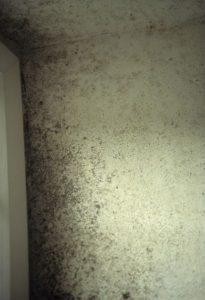
Mould
Cause
Organic mould on an interior wall surface which has penetrated into the plaster caused by damp, humid conditions.
This is generally caused by the lack of airflow within the area by keeping windows and doors closed. Allowing air to circulate freely from humid areas, such as bathrooms and kitchens should be standard practice. It should also be recognised that by turning the heating up, increasing the air temperature, a higher moisture content is held in the atmosphere and when in contact with colder surface condensation can rapidly occur.
The restricted airflow from humid conditions can result in mould forming in corners of rooms and behind household furniture.
Remedy
Allowing air to move freely to escape from humid areas such as bathrooms and kitchens should be standard practice.
It should also be recognised that by turning the heating up, more moisture can be held in the atmosphere and if allowed to settle onto a cooler surface condensation can rapidly occur onto wall surfaces.
Washing down with a solution of bleach and water can help to remove the mould, although proprietary fungicidal solutions may prove to be more effective.
Washing down should not be confined to the affected area but should include all adjacent walls and ceiling areas.
If the organic matter cannot be removed then it may be necessary to “hack off” and re-plaster.